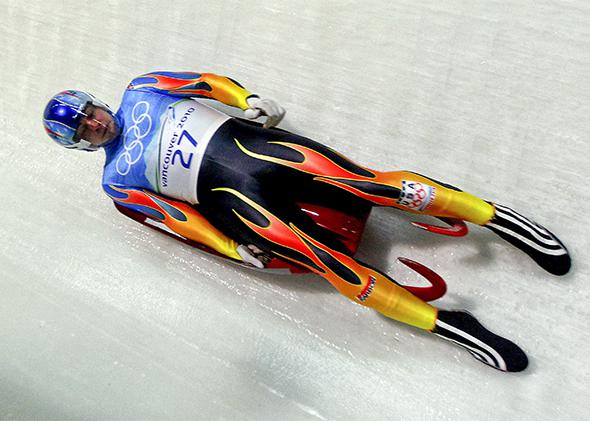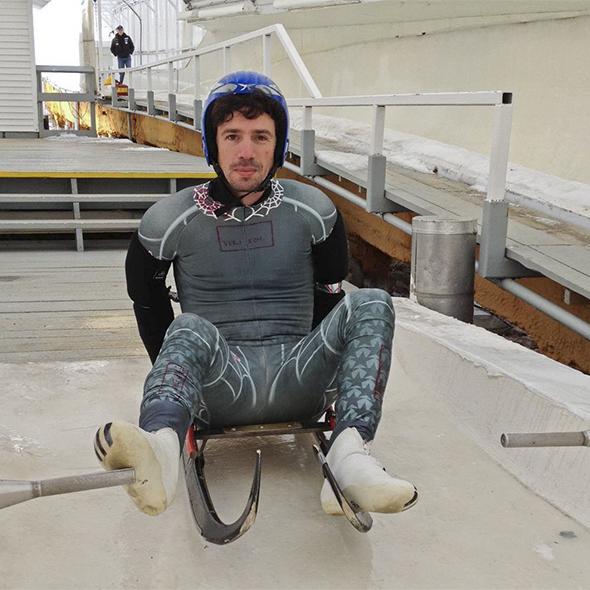Of the 15 sports in the Winter Games, surely the most relatable is the luge. There are many among us who have never snowboarded. Very few have tried curling. And I imagine that only a handful of us—people whom I hope never to encounter—go cross-country skiing with high-powered rifles strapped to our backs. Yet I would wager that any American child who has seen snow has also at some point attempted to sled down a hill.
Luge is essentially sledding at the Olympic level. Of course, the luge course isn’t actually a hill—it’s a chute that resembles a giant Krazy Straw. And the luge sled isn’t some dog-nibbled plastic saucer—it’s a finely tuned chariot with precision-honed steel runners. Luge is, in fact, the Platonic ideal of the sledding experience. I know, because last March, after pleading with the U.S. Olympic team, I got to try it myself.
I went to the Olympic training center in Lake Placid, N.Y., site of the 1980 Winter Games, and was met at U.S. luge team headquarters by Gordy Sheer. Sheer is currently marketing director for the United States Luge Association, but in his youth he won a silver medal in men’s doubles luge at the 1998 Winter Games in Nagano, Japan.* (Doubles luge is the Platonic ideal of sharing a small plastic saucer sled with your younger brother.) He promised to give me enough preliminary instruction to help me avoid embarrassing or maiming myself when I went out on the track.
We began at the team’s refrigerated indoor space. This warehouse-like room is the only such facility in the United States and one of about six in the world, according to Sheer. It mimics the first 100 feet or so of a luge course, with actual ice, allowing the luge athletes (cool kids call them “sliders”) to hone their start techniques. Sheer led me up some metal stairs to the elevated starting gate and sat me on a sled. Here, we practiced the propulsive launch that makes for a successful run. You grab a pair of bars on the sides of the gate with your hands and glide the sled’s runners back on the ice, coiling yourself so your chest presses down toward your knees. Then you rocket yourself forward with a smooth and powerful release.
At least, that’s the plan. My first few efforts left me in a gangly tangle of sled and human, careening dangerously toward the edges of the track. I’d dismount, lug 30-odd pounds of sled back up the staircase, and try again. Soon enough I’d figured out to sacrifice oomph for control as I settled for a less explosive but more accurate start. I eventually even learned to fairly smoothly transition from the seated start position into the supine riding position I’d be assuming for the length of the run.
As we toured the team facility, preparing to leave for the real course, we passed a complex-looking device with wires coming out of it. I asked Sheer what it was. He politely but firmly said, “Please don’t photograph that,” and then explained it was a “balance point” machine that analyzes the weight distribution of the sled. Top-secret tech.
It turns out luge is a sport rife with spying. The composition of the steel in the sleds’ runners is a proprietary secret, a recipe perfected through spectral analysis and kept from prying eyes. The geometry of the sleds themselves is jealously guarded. I met Duncan Kennedy, the luge team’s technical development manager (or, as he refers to himself, “chief sled tinkerer”), and got an earful of stories about luge espionage. “I’ve been up in trees with binoculars looking at other teams’ sleds,” he chuckles. “One time a German”—the Germans are acknowledged masters of luge—“left his sled unattended on a shuttle up to the top of the mountain. There were hands all over it.”
But now it was time to hit the actual course. We hopped in Sheer’s car and took a short drive to the nearby Mt. Van Hoevenberg, where the track is carved into the slope, surrounded by forest. Sheer brought me to a starting gate that feeds into the course about halfway down, so I wouldn’t be able to gather enough speed in my run to hurt myself too badly.

Photo by Ezra Shaw/Allsport/Getty Images
At the most recent Winter Games in Vancouver, Canada, a Georgian slider died on the course when he flipped out of the track during training and hit a structural pole at nearly 90 miles per hour. (I covered the International Olympic Committee press conference after the death.) Experienced sliders from around the world soon began to express their terror at the Vancouver course design, which sometimes generated speeds of around 95 miles per hour. The IOC elected to move the men’s start down to the women’s start gate and have women start from the juniors’ to hold speeds down. The track in Sochi, Russia, for the 2014 competition has been designed with an unprecedented three uphill sections to keep speeds under control.
All of which is to say: This is a scary sport. As I waited for the track announcer to call my start time over the PA—it’s very important to stagger the starts so sliders don’t collide with each other on the track and cleanly slice through each other’s tendons with sharp steel runners at high speed—Sheer had me keep warm in a little waiting hut next to the gate. I was zipped into my skintight bodysuit, which was apparently a backup or hand-me-down, as it had “VERIZON” scrawled in marker across the chest in lieu of actual sponsorship graphics. My feet were squeezed into aerodynamically shaped racing booties, thin enough that I could feel the front tips of the sled’s runners through my toes for more nuanced steering. I wore a helmet, which—though I needed no reminding—kept me constantly aware that I was about to go shrieking down a mountain, creating manifold opportunities to bash my head into things at tremendous velocity.
My countdown warning came. I brought my sled to the gate, boarded it, and waited for the starting beeps. And then I was off, settling myself back for the ride.
My first run was perhaps the most frightening and exhilarating thing—non-interpersonal relationships category—that I’ve ever experienced. Imagine a roller coaster, except you can steer it. And there’s no safety bar. And you’re just lightly perched atop a little tray with runners, holding on for dear life, nothing strapping you in.
The steering is amazingly responsive, with each nudge of your toes against the upturned front tips of the sled’s runners resulting in immediate directional change. Even just shifting your weight ever so slightly on the sled will alter your course. Sheer had advised me to steer as little as possible, since steering increases runner friction and slows you down. But it’s hard not to reflexively guide the sled away from oncoming walls.
The velocity and the curves are a legitimate shock. I don’t tend to be a wildly demonstrative fellow, but when I hit the first turn and climbed up the banked curve, with G-forces pressing into me, my body and sled now sliding perpendicular to the ground, I actually let out an involuntarily scream: “Hooooooooolyyyyy … ” I didn’t finish this complex and well-articulated thought, because by that point I was out of the curve and anticipating the next.
At the end of the run, the track angles uphill to slow your momentum. You put the soles of your feet down on the ice to brake your sled. Then you hop out of the chute and—if you’re like me—ask how soon you can make another run.
I got to make three runs, each more delightful than the last. By the third, I was no longer scared but thrilled. My “hooooooooolyyyyy” had turned into a “wheeeeeeee!” When I was all done, Sheer brought me up to the hut at the top of the track where the real sliders start. Several members of the national team were in the hut, watching their runs replay on the video machine. My final run came up on screen. Consensus held that I was not terrible for a beginner. Thanks to Sheer’s instruction, I had managed to handle things right when I bumped into a wall—immediately steering myself back toward that same wall to rein in my ricochet and avoid ping-ponging back and forth all the way down the course. But my head position was laughable. To be aerodynamic, you need to lay your helmeted head way back, peering down your nose at the track ahead. This is nearly impossible for a beginner. You’re a fragile being atop a teensy sled, rocketing down a frozen half-pipe, and you would very much prefer to see where you’re going. Ideally, not into a solid wall of ice.

Courtesy of Seth Stevenson
I asked the team what might happen to me if I tried to start from up here at the top. “The absolute best thing that could happen,” said one, “would be if you crashed in one of the first four turns. That way you wouldn’t be able to get going fast enough to really hurt yourself when you crashed later. And you definitely would crash later.”
The top speed I achieved was a hair under 36 miles per hour. Which, believe me, felt like about Mach 8. But for comparison: Also sliding that day was Chris Mazdzer, currently fifth in World Cup rankings and about to slide for our nation in Sochi. Mazdzer’s top speed on his runs that day was 71 miles per hour.

Photo by Richard Heathcote/Getty Images
If you’ve watched luge (or skeleton—the prone cousin to luge’s supine version of sledding) on TV before, with each run looking exactly like the last, you might have been tempted to think: That’s not sport. It’s just gravity. I can now assure you that each luge run is an intense and demanding athletic event. The margin of victory is measured in tenths of a second, so every infinitesimal weight shift or steering adjustment or bob of the head matters immensely. The best sliders can feel the track under them—intuiting the ice conditions moment to moment—and compensate on the fly, wringing every drop of speed out of the track.
If you don’t believe me, try it for yourself. The U.S. Luge Association is running a fundraising fantasy camp this April. You can tackle the same Lake Placid course as the national team and yours truly. Odds are you won’t discover the same latent sliding brilliance that I possess, but you never know. The favorite to win gold this year—and his sixth consecutive medal, dating back to 1994—is Armin Zöggeler, a 40-year-old Italian.
Still, your best bet for luge glory is to start young. Which makes sense: Luge is basically a childhood delight writ lethal. The U.S. luge team holds recruiting tours around the country, letting kids aged 9–13 ride wheeled luge sleds downhill. The tykes get up to about 25 miles per hour on a soapbox derby–type course. Sheer says he looks at the kids’ parents to extrapolate body types. (Tall and lean is best. Long arms mean stronger launches at the start, and more weight is a benefit in a gravity-dependent sport. But flab is not aerodynamic.)
Ultimately, though, sliding talent is a curiously innate skill. Says Sheer, “Some kids just have a gift for controlling the sled.”
Read the rest of Slate’s coverage of the Sochi Olympics.
Correction, Feb. 10, 2014: This article originally stated that the 1998 Olympic Games in Nagano, Japan, were in 1988. (Return.)
